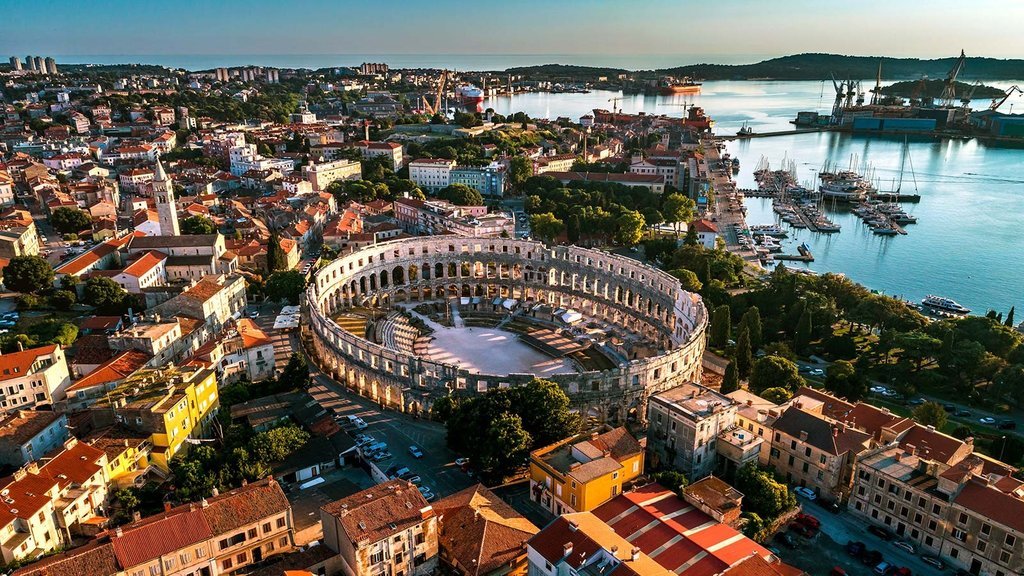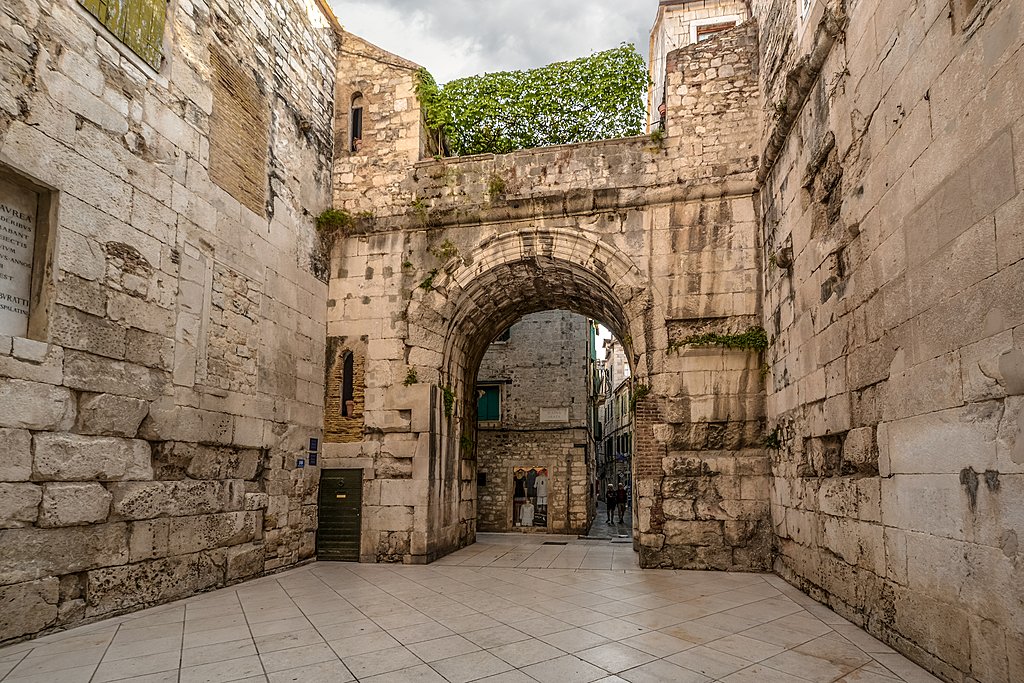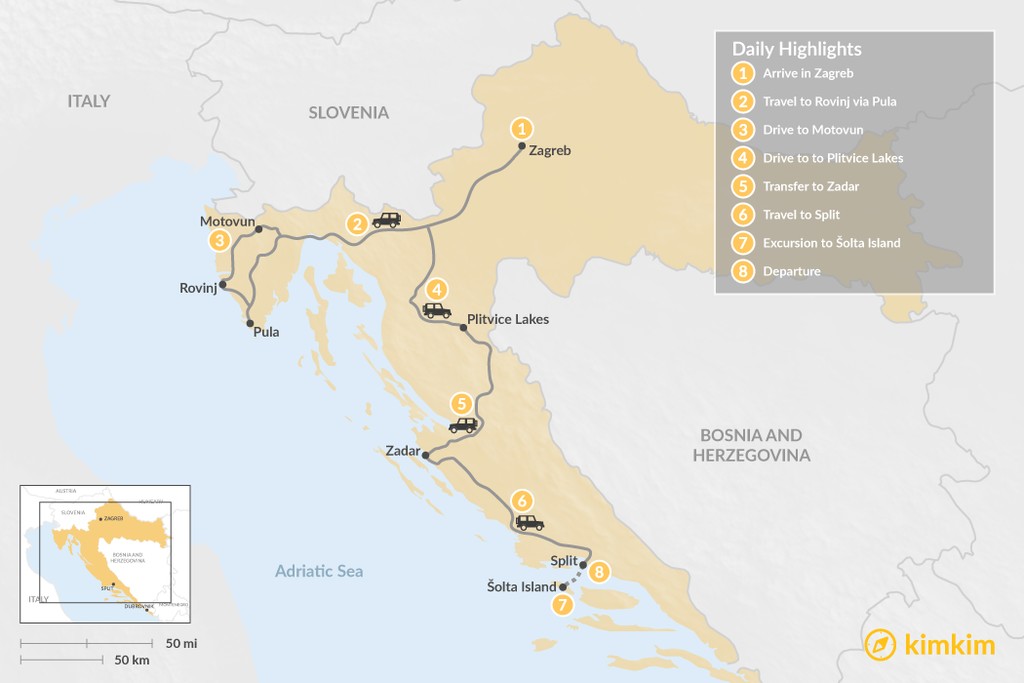Highlights
- Discover trendy cafés in Zagreb and stroll through leafy Maksimir Park
- Explore the Istrian Coast, from the streets of Rovinj to the ruins of Pula
- Walk amid beech and pine woods to marvel at Plitvice Lakes enchanting beauty
- Visit Šibenik's 16th-century St. Nicholas Fortress, a war architecture masterpiece
- Enjoy a fun day of sailing from Split to nearby Šolta Island
Brief Itinerary
| Day | Highlights | Overnight |
|---|---|---|
| Day 1 | Welcome to Zagreb! | Zagreb |
| Day 2 | Zagreb to Rovinj, Stopping in Pula | Rovinj |
| Day 3 | Into the Heart of Istria: Grožnjan, Oprtalj, & Motovun | Rovinj |
| Day 4 | Rovinj to Plitvice Lakes National Park via Opatija | Plitvice Lakes |
| Day 5 | Sunrise at Plitvice Lakes, Drive to Zadar | Zadar |
| Day 6 | Zadar to Split, Stopping in Šibenik | Split |
| Day 7 | Sail & Swim around Šolta Island | Split |
| Day 8 | Depart Split |
Detailed Itinerary
Day 1: Welcome to Zagreb!

Start your adventure from Zagreb, the capital of Croatia. Upon arrival at the airport, you'll be transferred to your hotel to settle in. The rest of the day is yours to spend as you like. The city center is easily walkable and the streets and parks are easy to navigate by foot. All the main attractions and restaurants are within walking distance.
A gem of a European city, Zagreb is at once historic and new. It's filled with leafy green parks and gothic/neo-renaissance buildings, yet there's also modern shopping complexes, outdoor malls, and endless dining and drinking options. Consider heading out on a guided walking tour of the historic heart of the city. This involves walking from the main square to Zagreb's Upper Town and passing through local markets before reaching St. Mark's Square.
Alternatively, you can visit one of the many museums and art galleries, like the Homeland War Museum, the Nikola Tesla Technical Museum, or the ever-popular Museum of Broken Hearts. Or stroll through the city center, enjoying 17th-century neo-baroque architecture found at Zagreb's Art Pavilion and Croatian National Theater.
Zagreb also has a number of beautiful city parks which are great for exploring and people watching, especially in the late afternoon. Maksimir is a great option, with a variety of cafés nearby to pick up a coffee for your stroll.
Day 2: Zagreb to Rovinj, Stopping in Pula

Get an early start this morning to make the scenic drive west to Rovinj, stopping first in historic Pula. Its strategic location at the southern tip of the Istrian peninsula means it has been occupied many times throughout the centuries by everyone from the Romans to the Allied Forces in WWII. While Pula is known for its beaches and harbor, it's most famous for its Roman amphitheater, the Pula Arena, which dates back to the first century.
Take your time to explore the city. You'll no doubt want to make a beeline for the arena, which is one of the 10 largest colosseums the Romans ever built. Stand in the tunnels and corridors where warriors and lions were kept before entertaining crowds of up to 25,000. But that isn't all—there are many other ruins you can visit here. These include the Arch of the Sergii—an ancient Roman arch dating to 29 BCE—and the Temple of Augustus, a Roman temple built in 2 BCE.
When it's time, continue along the coast to Rovinj where you'll settle into your accommodation before taking the rest of the afternoon and evening to explore this small jewel on the west coast of Istria.
Though Rovinj remains an active fishing port today, it wasn't until 1763 that it became part of the mainland. As such, its restricted access resulted in the labyrinth of narrow, cobblestoned streets you see today. Explore Old Town and marvel at the centuries-old Venetian influenced architecture as you pass under archways, through alleyways, and up stone stairwells. Navigate your way to Balbi's Arch and the 12th-century Town Clock, noting Rovinj's skyline dominated by the baroque St. Euphemia Church.
Seek out your choice of interest from churches to galleries and pebbled beaches, capping off the day with a delicious dinner of fresh fish and local wines, like Teran and Malvasia.
Driving time (Zagreb to Pula): 3 hours
Driving time (Pula to Rovinj): 45 minutes
Day 3: Into the Heart of Istria: Grožnjan, Oprtalj, & Motovun

Today, head inland to explore the rolling hills of Istria, taste a few of the best local olive oil and wine varieties and explore some of the most charming villages in the country.
First, drive north to Grožnjan, a medieval hilltop town surrounded by terraced olive groves and vineyards. Once an important stronghold for the Venetians, the town's importance went into decline with the collapse of their empire (in the 18th-century). It wasn't until the sixties Grožnjan became what it is today: the town of artists. Lose yourself in the maze of narrow and cobblestoned streets, stopping to pop into one of the numerous art studios and galleries.
Then, continue on to Oprtalj, a medieval fort town sitting on the northern side of the Mirna river valley. Oprtalj is home to traditional narrow streets, shops, and fine examples of Istrian and Venetian architecture, including the 16th-century St. George's Church and Venetian style bell tower.
Finally, drive south to explore Motovun, an ancient sleepy town located atop a 909-foot (277 m) hill. Its present appearance, with the city walls surrounding the center of the town, dates back to the Middle Ages. Sitting opposite Oprtalj on the southern side of the Mirna river, Motovun today hosts a popular film festival for one week in the summer. Sample local wines and enjoy a meal with truffles sourced from the nearby truffle-rich forests.
Driving time (Rovinj to Grožnjan): 1.25 hours
Driving time (Grožnjan to Oprtalj): 30 minutes
Driving time (Oprtalj to Rovinj): 1.25 hours
Chat with a local specialist who can help organize your trip.
Day 4: Rovinj to Plitvice Lakes National Park via Opatija

This morning you'll make the drive to Opatija before carrying on to Plitvice Lakes National Park, one of Croatia's most popular national parks.
Head northeast across the Istrian Peninsula and stop in the coastal town of Opatija. A popular tourist destination since the 19th century, Opatija is known for its Mediterranean climate and historic Habsburg-era buildings, remnants of its touristic past. Stroll along the famous Lungomare, a promenade that follows the Adriatic coastline and enjoy a drink at one of the many bars that overlook the Kvarner Gulf.
Continue east to Plitvice Lakes National Park, arriving in the afternoon to settle into your accommodation and to explore the park at your leisure. A must-visit for any traveler to Croatia, the UNESCO-protected park is comprised of an exquisite collection of 16 glassy emerald green and blue travertine lakes, more than 90 cascading waterfalls that seemingly cover every corner of the park, and numerous caves. The terraced lakes are surrounded by beech and pine forests and are home to extensive wildlife.
Here, you can request a private, expert local guide to lead you throughout the park along the wooden paths and bridges to show you the most impressive points of interest and explain the significance of its history and natural features. After your tour, you will have free time to continue exploring, have dinner, or you may wish to bring a bought dinner (and a bottle of wine!) with you to enjoy a picnic.
Driving time (Rovinj to Opatija): 1.5 hours
Driving time (Opatija to Plitvice): 2.5 hours
Day 5: Sunrise at Plitvice Lakes, Drive to Zadar

Early morning is one of the best times to visit Plitvice Lakes before the mid-day crowds arrive. You can explore the park on your own or opt for a local guide who will take you on a number of defined routes of varying lengths throughout the park. After enjoying a leisurely morning in Plitvice, carry on your way south to the ancient capital of Zadar, the perfect city to arrive in after a day in the storybook wilderness.
A historical center of the Dalmatian Coast, Zadar is famous for its picturesque coastline full of islands and vibrant blue waters, as well as fresh seafood and unforgettable sunsets. Take the rest of the day to relax and explore. You may wish to stroll along Zadar's Riva, a wide ribbon of stone paths bordered by a grassy park on one side and the sea on the other. It runs along Old Town’s waterfront, where it comes alive at night with vendors and Dalmatian a capella groups called Klapa that serenade the passersby, including folks on yachts who dock there.
Take in a legendary sunset (Alfred Hitchcock is on record saying they're the best in Zadar) from Café Brazil before discovering the pretty patterned lights of the Monument to the Sun while listening to the nearby Sea Organ.
Driving time: 1.5-2 hours
Day 6: Zadar to Split, Stopping in Šibenik

This morning you'll continue south along the Dalmatian coast to Split, breaking up the journey to explore Šibenik. A true Croatian town founded by the Croat king Petar Krešimir IV in the 11th century, Šibenik is home to impressive fortresses, music festivals, and medieval gardens. Start with a visit to the famous UNESCO-protected St. James' Cathedral, before selecting a restaurant for your lunch—perhaps Pelegrini, a restaurant and wine bar just above the cathedral. If there's time, check out the 16th-century war architecture masterpiece, St. Nicholas Fortress.
From here, carry on your way south to Split. Upon your arrival, check into your hotel and settle in before taking the rest of the afternoon to wander Split's historic center.
Start at Pjaca Square for pretty views of white marble tiles, the Iron Gate (the western entrance to Diocletian's Palace), a Romanesque clock tower with the remains of a medieval sundial, and the 15th-century Town Hall. Stop for lunch at Trattoria Bajamont, just north of the Iron Gate. From there, visit the popular Voćni trg or Fruit Square. Here you can enjoy renaissance architecture, influenced during Split's Venetian era. For a bit of shopping and a bite to eat head to Marmont Street, though you'll want to make your way to the waterfront to catch the sunset.
In the evening, take a stroll along Split's seafront Riva to admire the views over the Adriatic before finding the off-beat Konoba Dioklecijan restaurant, just to the left of the Bronze Gate for dinner, its outdoor terrace built into the walls of famed Diocletian's Palace.
Driving time (Zadar to Šibenik): 1 hour
Driving time (Šibenik to Split): 1.5 hours
Day 7: Sail & Swim around Šolta Island

Today you will spend a full day enjoying the sun and sea on a sailing boat with time left over to explore Šolta Island. Head to the Split marina to meet your captain and crew, before departing for Šolta, your speed and route determined by weather conditions.
You'll stop for swimming breaks, taking advantage of the many beaches and pristine coves this sleepy island has on offer. Once on Šolta, you'll have the chance to explore the small town of Stomorska as well as have lunch in one of its local restaurants. Though Šolta is so close to Split, it is far from modern life, further adding to its understated charm.
You'll return to Split in the late afternoon.
Day 8: Depart Split

If you have a free morning before departing, check out the Green Market (Pazar Market). A lively fruit and vegetable outdoor market just east of the Diocletian Palace, this is a great place to see how the locals shop and to pick up some fruit for your flight home. Farmers from the surrounding areas of Split come into town every day to sell their seasonal local produce from sunrise to 2 pm.
Depending on traffic, it usually takes 45 minutes to travel from Old Town to the airport. Best to arrive at the airport at least two hours prior to your international departure (and with some extra time to drop off your rental car, if you have one).


